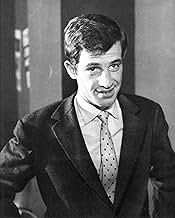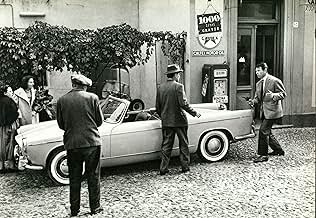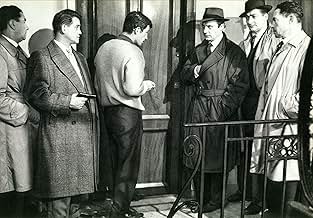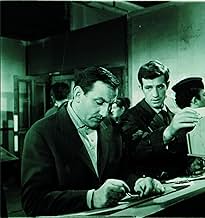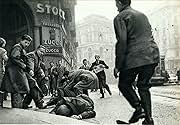Classe tous risques
- 1960
- Tous publics
- 1h 50min
NOTE IMDb
7,5/10
4,8 k
MA NOTE
Abel Davos est un criminel, traqué en Italie. La police se rapproche, alors lui et son copain Raymond s'arrangent pour s'enfuir en France avec la femme d'Abel, Thérèse, et leurs deux jeunes ... Tout lireAbel Davos est un criminel, traqué en Italie. La police se rapproche, alors lui et son copain Raymond s'arrangent pour s'enfuir en France avec la femme d'Abel, Thérèse, et leurs deux jeunes fils.Abel Davos est un criminel, traqué en Italie. La police se rapproche, alors lui et son copain Raymond s'arrangent pour s'enfuir en France avec la femme d'Abel, Thérèse, et leurs deux jeunes fils.
- Réalisation
- Scénario
- Casting principal
Simone Desmaison
- Thérèse Davos
- (as Simone France)
Jean-Pierre Zola
- Le patron de l'agence privée
- (as J.P. Zola)
Philippe March
- Jean Martin
- (as Aimé de March)
Avis à la une
Both Bresson and Melville are reputed to be big fans of "Classe Tous Risques" and it's easy to see why; either man could have directed this classic French gangster picture. The actual director was Claude Sautet and it's one of the greatest second films in movie history, (in the 15 year period between 1956 and 1970 Sautet made only 4 films). He made this one in 1960 around the time of the New Wave and while it's more traditional than something Godard or Truffaut might have done, nevertheless Sautet brings to it a freshness of approach that other gangster pictures of the period seem to lack. From the absolutely stunning opening sequence it's clear that this film will be infused with a good dose of existential angst as well as the requisite thrills that a really good gangster movie needs.
Two fugitives, (Lino Ventura and Stan Krol), have decided it's time to get out of Italy and back to France as the net closes in around them but they need money. They commit a foolhardy, though daring, daylight robbery and go on the run. This opening and the chase that follows is as good as anything in crime movies. The money they make, however, is hardly enough to sustain them, (Ventura has a wife and two sons to support), so they must rely on a network of friends and criminal associates and men on the run, already operating on the very edge, need all the friends they can get, however untrustworthy they may be and these guys friends prove to be very untrustworthy indeed but when tragedy strikes Ventura seems to have no option.
With the possible exceptions of Dassin's "Rififi" and several of Jean-Pierre Melville's classic gangster pictures this remains one of the greatest of genre films and is all the better for being, fundamentally, a low-key character piece. Ventura is perfect as the world-weary thief who would really rather just settle down and raise his family and he is matched by a young Jean-Paul Belmondo as the stranger who becomes his only real friend and ally. The brilliant black and white cinematography is by Ghislain Cloquet, (it was shot largely on location), and it is beautifully adapted by Sautet, Pascal Jardin and Jose Giovanni from Giovanni's novel.
Two fugitives, (Lino Ventura and Stan Krol), have decided it's time to get out of Italy and back to France as the net closes in around them but they need money. They commit a foolhardy, though daring, daylight robbery and go on the run. This opening and the chase that follows is as good as anything in crime movies. The money they make, however, is hardly enough to sustain them, (Ventura has a wife and two sons to support), so they must rely on a network of friends and criminal associates and men on the run, already operating on the very edge, need all the friends they can get, however untrustworthy they may be and these guys friends prove to be very untrustworthy indeed but when tragedy strikes Ventura seems to have no option.
With the possible exceptions of Dassin's "Rififi" and several of Jean-Pierre Melville's classic gangster pictures this remains one of the greatest of genre films and is all the better for being, fundamentally, a low-key character piece. Ventura is perfect as the world-weary thief who would really rather just settle down and raise his family and he is matched by a young Jean-Paul Belmondo as the stranger who becomes his only real friend and ally. The brilliant black and white cinematography is by Ghislain Cloquet, (it was shot largely on location), and it is beautifully adapted by Sautet, Pascal Jardin and Jose Giovanni from Giovanni's novel.
10urigafni
Odd one should be able to stumble into "Classe Tous Risques" only by chance; it should be on any "best of film-noir" list, including IMDb's.
Lino Ventura is as good as ever; knowing of his dire, delicate family situation gives extra weight to his almost expressionless face and brief dialogues. Belmondo's restrained performance under Sautet's firm direction only shows what a wonderful actor he could - and should -have been.
"Classe Tous Risques" is utterly mininal, dry and cold, without Melville's artistic scenery, pretty faces and fancy cars. It is almost film-noir meet neo-realism. Davos' few, hard words to his children describing their life of secrecy from there on get a hold on your throat to the end of the film.
The final sentence of the film - a voice-over telling of Davos' end in no more than ten dry, sombre words - leaves you with a hard punch in the stomach.
A true jewel in the great crown of French film-noir.
Lino Ventura is as good as ever; knowing of his dire, delicate family situation gives extra weight to his almost expressionless face and brief dialogues. Belmondo's restrained performance under Sautet's firm direction only shows what a wonderful actor he could - and should -have been.
"Classe Tous Risques" is utterly mininal, dry and cold, without Melville's artistic scenery, pretty faces and fancy cars. It is almost film-noir meet neo-realism. Davos' few, hard words to his children describing their life of secrecy from there on get a hold on your throat to the end of the film.
The final sentence of the film - a voice-over telling of Davos' end in no more than ten dry, sombre words - leaves you with a hard punch in the stomach.
A true jewel in the great crown of French film-noir.
In Milan, the gangster Abel Davos (Lino Ventura) is sentenced to death "In absentia" and decides to return to France. Abel is a family man with wife Thérèse Davos (Simone France) and two sons, and his partner Raymond Naldi (Stan Krol) helps Abel and his family to flee to Nice. However Thérèse and Raymond are killed by the police and Abel uses his former friends in Paris to help him to go to Paris with his sons. They hire the driver Eric Stark (Jean-Paul Belmondo) to bring Abel and his kids to Paris in an ambulance. Along their journey, Eric helps the aspirant actress Liliane (Sandra Milo) on the road and she also goes to Paris in the ambulance. But soon Abel learns that he is alone and his friends when he was powerful will not help him and he counts only with the support of Eric. What will happen to him?
"Classe tous risques" is a great film-noir with the story of the last days of a gangster. The plot shows that there is no code of honor or friendship after the fall of a powerful gangster. All his former friends do not help him when he needs. The conclusion is adequate for the whole situation. My vote is eight.
Title (Brazil):"Como Fera Encurralada" ("Like Trapped Beast")
"Classe tous risques" is a great film-noir with the story of the last days of a gangster. The plot shows that there is no code of honor or friendship after the fall of a powerful gangster. All his former friends do not help him when he needs. The conclusion is adequate for the whole situation. My vote is eight.
Title (Brazil):"Como Fera Encurralada" ("Like Trapped Beast")
"Classes tous risques" is one of the best "gangsters" films noirs France has ever produced.Perfect cast :Lino Ventura,a young Jean -Paul Belmondo (who made "a bout de souffle",Godard's thing, the same year),Marcel Dalio and a fine supporting cast ;brilliant script by José Giovanni -who also wrote "le trou" Becker's masterpièce the same year!What a year for him!;wonderful black and white cinematography by Ghislain Cloquet.And taut action,first-class directing by Claude Sautet,who surpasses Jean-Pierre Melville .Whereas the latter films gangsters movie with metaphysical pretensions,which sometimes lasts more than two hours,Claude Sautet directs men of flesh and blood,and the presence of the two children adds moments of extraordinary poignancy which Melville has never been able to generate .And Sautet avoids pathos,excessive sentimentality:the last time Ventura sees his children,coming down in the metro (subway)is a peak of restrained emotion.
Ventura portrays a gangster whose die is cast when the movie begins.He thinks that he can rely on his former acquaintances ,but they are all cowards -we are far from manly friendship dear to Jacques Becker ("touchez pas au grisbi" ) which Melville was to continue throughout the sixties-sometimes abetted by mean women (the film noir misogyny par excellence),living in a rotten microcosm,ready to inform on -we are far from Jean Seberg's simplistic behavior in Godard's "opus"-.
Cloquet works wonders with the picture:the scene on the beach in a starless night when the two children see their mother die after the shoot-out with the customs officers is absolutely mind-boggling.
There's a good use of voice-over,which Sautet only uses when necessary;thus ,the last lines make the ending even stronger than if we have attended the scenes.
Claude Sautet had found a good niche ,and he followed the "classes tous risques" rules quite well with his follow-up "l'arme à gauche" (1965) which featured Ventura again and made a good use of a desert island and a ship.Had he continued in that vein,France would have had a Howard Hawks.In his subsequent works ,only "Max et les ferrailleurs " (1971) showed something of the brilliance he displayed in the first half of the sixties.He had become ,from "les choses de la vie" onwards,the cinema de qualité director who used to focus on tender-hearted bourgeois in such works as "Cesar et Rosalie" (1972),"Vincent François ,Paul et les autres" (1974) or "Mado" (1976)
Ventura portrays a gangster whose die is cast when the movie begins.He thinks that he can rely on his former acquaintances ,but they are all cowards -we are far from manly friendship dear to Jacques Becker ("touchez pas au grisbi" ) which Melville was to continue throughout the sixties-sometimes abetted by mean women (the film noir misogyny par excellence),living in a rotten microcosm,ready to inform on -we are far from Jean Seberg's simplistic behavior in Godard's "opus"-.
Cloquet works wonders with the picture:the scene on the beach in a starless night when the two children see their mother die after the shoot-out with the customs officers is absolutely mind-boggling.
There's a good use of voice-over,which Sautet only uses when necessary;thus ,the last lines make the ending even stronger than if we have attended the scenes.
Claude Sautet had found a good niche ,and he followed the "classes tous risques" rules quite well with his follow-up "l'arme à gauche" (1965) which featured Ventura again and made a good use of a desert island and a ship.Had he continued in that vein,France would have had a Howard Hawks.In his subsequent works ,only "Max et les ferrailleurs " (1971) showed something of the brilliance he displayed in the first half of the sixties.He had become ,from "les choses de la vie" onwards,the cinema de qualité director who used to focus on tender-hearted bourgeois in such works as "Cesar et Rosalie" (1972),"Vincent François ,Paul et les autres" (1974) or "Mado" (1976)
10colaya
A film reduced to its essentials (photographed images in sequence) to portray the dawn and dusk of two stoical gangsters that are also human beings. Milan, Nice, Paris, a journey from exile to tragedy, the disloyalty of old partners, a total stranger that becomes the younger image in the mirror, a new friendship---in Sautet hands, all of these human happenings are conveyed not by words but by the power of images, expressions, action, angles, movement, gestures, moments. Sautet belongs to the same league of Melville, Bresson and other masters of the craft of putting together "pictures in motion".
"Less is more". Minimalism assumes that the moviegoer is a human being too, s/he interprets, reflects, makes sense and finds meanings. No distractions and full advantage of the cinematic form: images, sound, edition. Not everything has to be shown or explained. Less words and less information demand for the viewer to fill in the blanks, an active role that might be hard to take. But once the watcher accepts the challenge, the outcome is a tailor-made experience---he is not a passive watcher anymore.
"Less is more". Minimalism assumes that the moviegoer is a human being too, s/he interprets, reflects, makes sense and finds meanings. No distractions and full advantage of the cinematic form: images, sound, edition. Not everything has to be shown or explained. Less words and less information demand for the viewer to fill in the blanks, an active role that might be hard to take. But once the watcher accepts the challenge, the outcome is a tailor-made experience---he is not a passive watcher anymore.
Le saviez-vous
- AnecdotesCo-writer/Director Claude Sautet said after the shooting that he did not know that the Abel Davos - Danos - character was inspired by a gangster who collaborated with the Nazis against French resistance and Jews during German occupation.
- Citations
Eric Stark: The best thing about me is my left hook.
- ConnexionsFeatured in Claude Sautet ou La magie invisible (2003)
Meilleurs choix
Connectez-vous pour évaluer et suivre la liste de favoris afin de recevoir des recommandations personnalisées
- How long is The Big Risk?Alimenté par Alexa
Détails
Box-office
- Montant brut aux États-Unis et au Canada
- 132 928 $US
- Week-end de sortie aux États-Unis et au Canada
- 11 945 $US
- 20 nov. 2005
- Montant brut mondial
- 132 928 $US
- Durée1 heure 50 minutes
- Couleur
- Rapport de forme
- 1.66 : 1
Contribuer à cette page
Suggérer une modification ou ajouter du contenu manquant

Lacune principale
What is the Mexican Spanish language plot outline for Classe tous risques (1960)?
Répondre




